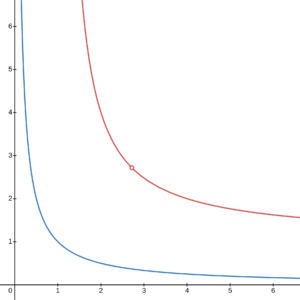In Dilemma 8, we investigated a curve similar to an ellipse, but changing addition to multiplication in its definition. This time, PMP participant William Keehn proposes a similar exploration related to the hyperbola, another conic section, which can be thought of as all of the points in the plane where Since that description already involves multiplication, this time we will move on to exponentiation.

So, now consider all of the points where such that and are distinct positive real numbers. You get a curve somewhat resembling a hyperbola, that William has dubbed the “experbola.” Figure 1 shows the hyperbola and experbola side-by-side. And William is brimming with interesting questions about the experbola, so Dilemma 13 has lots of parts:
- Find all of the points on the experbola where both coordinates are whole numbers. (And explain why there aren’t any others.)
- An asymptote of a curve is a straight line that the curve becomes arbitrarily close to but never touches. For example, the hyperbola in Figure 1 has two asymptotes: the lines and Does the experbola have any asymptotes? If so, find them.
- The condition that and are distinct is needed because whenever they are the same, the equation is trivially satisfied. So without that condition, the experbola would include the entire diagonal line But as you can see in Figure 1, that condition also cuts the experbola into two disconnected pieces. However, there is a unique single point on the line that you could add back to the experbola to “complete” it and make it a single continuous curve. (That’s the point indicated by the small red open circle in Figure 1.) What are the coordinates of that point?
- Find (continuous, non-constant) functions and such that the point is on the experbola for all positive real numbers . For this one, William offers a hint, by way of an example: Such a pair of functions is called a parametrization of the experbola, or at least of the part of the experbola it lands on.
